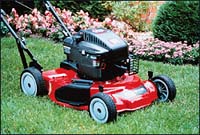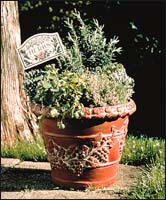The 30-foot southern magnolia at the corner of our driveway
does double duty. Its glossy green leaves and scented flowers provide year-round interest
to our landscape, plus it attracts lots of birds seeking shelter.
More Diggin' In |
CATCH KATHY!
See "Diggin’ in" at 12:57 and 8:56 p.m. Saturdays and 8:56 p.m.
Thursdays on WHRO TV 15, brought to you by McDonald Garden Center.Make a hat for Kathy
to wear on one of the segments and win a $20 gift certificate to McDonald Garden Center
and a pair of passes to Norfolk Botanical Garden.
WHRV-FM’s Hear/Say noon-1 p.m. July 18.
Read the "Diggin' In" column from Sunday's
Daily Press.
Hear Kathy’s gardening tips on the 1-Line anytime:
757-928-1111, category 4769 (GROW).
The gardening trivia contest takes summer vacation, returning in
September.
Post your gardening tips on our message boards
to be eligible for giveaways.
|
Best of all, the magnolia keeps the steamy sun from baking our home during hot summer
evenings.
Over the years, I've learned trees and shrubs can be our friend or foe when it comes to
cooling our home during summer and warming it during winter.
Trees such as river birches provide nice dappled shade; crape myrtles entertain us with
beautiful blooms while protecting us from the heat. Just be careful where you place trees.
The roots of river birches can disrupt walks and driveways; flower petals from crape
myrtles can litter a patio or water garden.
Before you plant trees and shrubs to shade your home, observe how the sun rises and
sets across your property. Then you can plant with real purpose.
Here are some landscape-cooling tips from the U.S. Department of Energy, Virginia
Cooperative Extension, North Carolina Solar Center, North Carolina Energy Division and
North Carolina State University:
SUMMER SENSITIVITY
Shade the east and west sides of your house. These sides of your home and the roof face
the greatest amount of summer sun. More energy enters through windows than through
insulated walls, so concentrate on shading windows; when replacing windows choose ones
that reflect heat and glare.
Give priority to shading the west over shading the east, because heat from afternoon
sunlight comes when the house has built up heat all day, outdoor temperatures have peaked
and your family is probably at home.
Extended overhangs, fixed or movable awnings, shade screens and covered porches are
great for the south side.
Plant to shade areas surrounding the house. Even though trees to the north can't shade
the house directly, they reduce air and ground temperatures surrounding the house and
reduce the light reflected into it. They also shade the compressor on your air conditioner
or heat pump; this improves its performance, reduces its noise and improves your home's
appearance. Place plants so they or their fallen leaves do not block airflow to the unit.
Shade your roof. Do this with care, carefully choosing and placing trees so they will
not damage your roof with too much shade or fallen limbs. In general, trees should not be
planted closer than 10 or 15 feet from the house's foundation. Because of this, it is
usually practical only to shade portions of the roof.
The best tree for this work will be tall with a wide canopy that extends over your roof
without shading it so much that mildew forms on your shingles; when replacing your roof,
make sure you choose mildew-resistant shingles.
Use shrubs to shade walls and windows. Shrubs grow faster than trees and can be planted
closer to the house since their root structures are less likely to cause damage. On the
other hand, plant shrubs far enough away from your home to allow circulation, or mildew
can form; this space also makes it easy to do exterior maintenance on your home.
Train vines to climb string, wire, trellis or arbor structures to provide localized
shade in the summer. Vines are a quick way to provide shading and cooling, while screening
out unwanted views and providing privacy. Set vines and trellises far enough from the
exterior walls of a home so air circulates behind the trellis.
Trees and vines can create a cool microclimate, reducing the temperature by as much as
9 degrees Fahrenheit in the immediate area. During their food-making process, large
amounts of water vapor escape through their leaves, cooling the passing air.
Ground covers can be cool. Ground covers significantly reduce the temperatures
surrounding the house and reduce the amount of sunlight reflected into windows. The
temperature above a healthy lawn can be more than 10 degrees cooler than that above a
concrete or asphalt surface. Even lower ground temperatures may be achieved with ground
covers with irregular surfaces such as longer grasses, vines or shrubbery.
SUBSCRIBERS WIN
Magazine subscribers Vanessa Caldwell of Gloucester and Tron Napier of Portsmouth each
win an Espoma organic gardening package; visit www.espoma.com.
HELPFUL PLANTS
Evergreen shrubs and trees for privacy, cooling screens and windbreaks include: aucuba,
fragrant osmanthus, wax myrtle, Japanese cleyera, American boxwood, camellia, golden
arborvitae, dwarf Alberta spruce, skyrocket juniper, Italian cypress, mahonia, evergreen
clematis or cross vine (on trellises), sweet bay magnolia, Little Gem magnolia, lusterleaf
holly, Foster holly, Nellie Stevens holly, cherry laurel, Otto Luyken laurel.
Source: Southern Gardener’s Book of Lists by Lois Trigg Chaplin ($17.95)
WINTER WAYS
Landscape your home for wintertime protection. Plant evergreens as windbreaks to guard
against wind hitting your house full force.
The windbreak needs to be at least as tall as the house it is to shield, and should be
located at a distance of one to three times its height away from the house. The windbreak
should be dense, allowing 25 to 60 percent of the air to flow through, rather than solid,
because solid windbreaks create turbulence behind them.
The density of the windbreak should be maintained from the ground up without major
gaps. A mixture of various shrubs and trees can help prevent these gaps.
Too many homeowners gravitate to single plants such as Leyland cypress to create a
plant wall to screen out wind and unwanted views. Don’t get me wrong. Leyland cypress
is a wonderful plant put in the proper place. Too often, however, the plants are not given
enough space to grow to maturity without crowding each other. These plants grow 15 to 20
feet wide and 40 to 60 feet tall. They need to have good air and light circulation in and
among the plants or they suffer pests and disease problems.
It is also a good idea to mix species within the windbreak to avoid the possibility of
losing the entire windbreak to a disease that affects one species.
ENTER BEAUTIFUL GARDENS CONTESTS

Enter the Beautiful Gardens Contests to win a Toro lawnmower
or American Designer Pottery by Fiskars.
American Designer Pottery
|
Here we go again, sponsoring contests to feature your beautiful gardens and to give
away great prizes. This spring/summer we feature two:
- "Beautiful Gardens" with lawns, water gardens, perennials, benches, flowers,
shrubs and more. Enter your springtime landscape in our "Beautiful Gardens"
contest to win a Toro Personal Pace lawnmower (value $420; www.toro.com;
see one at Nick’s Lawn & Garden in Yorktown). Send in up to six color photos of
your gardens by Sept. 14. We will choose six of the best looking gardens/yards
from those photos and feature them in a fall magazine and online. Readers will vote for
the winner through out Daily Press 1-Line (number to be published in October magazine) and
online.
- "Beautiful Containers" featuring your best pots, window boxes or patio
planters filled with flower, herb, shrub, perennial or bulb combinations in stunning
bouquets. Please indicate the names of plants used in containers. First-, second-
and third-place winners win American Designer Pottery by Fiskars (www.fiskars.com).
- To enter, send your photos (labeled with your name, address and daytime telephone
number) to Hampton Roads Gardening & Home magazine, c/o Daily Press, 7505 Warwick
Blvd., Newport News, 23607 by Sept. 14.
FIND YOUR HEAT ZONE
Most of the area is in heat Zone 7 (average 60-90 days per year over 86 degrees F.),
says Bonnie Appleton, horticulture professor at the Hampton Roads Agricultural Research
and Extension Center in Virginia Beach. Areas along the shore are in heat Zone 6 (45-60
days over 86 degrees F., the temperature at which photosynthesis shuts down). People can
go to the American Horticultural Society’s Web site and type in their ZIP code and it
will tell them their zone: www.ahs.org/publications/zipfinder.htm.
To join the AHS or order the AHS Plant Heat-Zone Map, visit www.ahs.org; e-mail membership@ahs.org; or call (703) 768-5700, Ext. 121.

